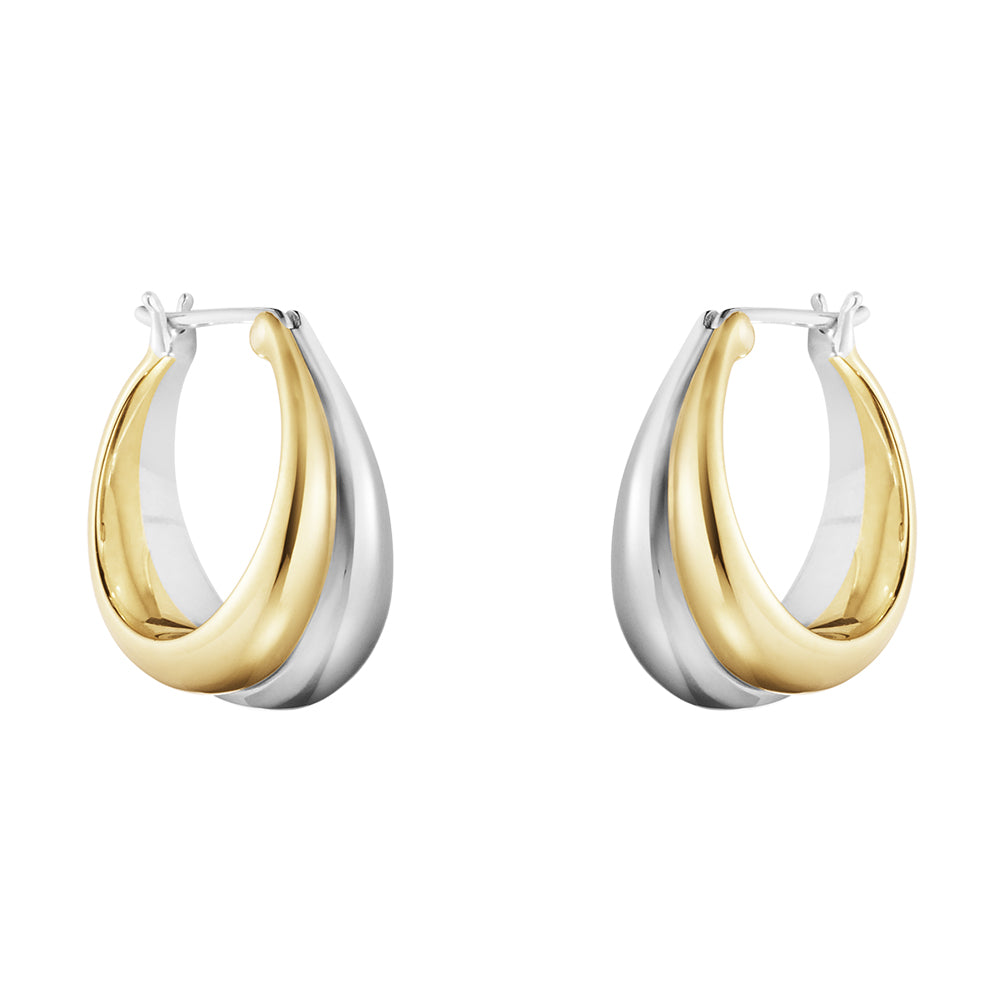
Can You Sleep With Earrings In? Safety & Comfort Tips
Introduction
Sleeping with earrings seems harmless, yet it hides a web of biological, hygienic, and material concerns. Understanding how earrings interact with your skin and sleep patterns helps prevent infections, discomfort, and long-term ear damage—while enhancing your appreciation for the artistry of jewelry.

Ear Piercings and Sleep: Lobe vs. Cartilage Risks
Your earlobes and cartilage are not just decorative spaces—they are delicate tissues, rich with tiny blood vessels and nerves. According to the American Academy of Dermatology (AAD), piercing sites are essentially small wounds that require care until fully healed.
Lobes vs. Cartilage:
Earlobes are fleshy and more forgiving. Sleeping with studs in the lobe may cause minor discomfort but rarely serious damage if the earrings are small and smooth. Nevertheless, continuous pressure during sleep, especially on one side, can subtly stretch the tissue over time, leading to elongation or minor irritation that might only become noticeable after months of nightly wear. For those who enjoy wearing statement studs or heavier designs, awareness of how gravity and pillow positioning affect the earlobe tissue is crucial.
Cartilage piercings, however, are prone to perichondritis, a bacterial infection that can cause swelling, severe pain, and permanent deformation. Sleeping with cartilage earrings increases friction and pressure, which can slow healing or trigger infection. Even small, seemingly harmless earrings can become problematic if they constantly rub against the pillowcase or bedding, creating microtraumas that compromise the protective skin barrier.
Scientific insight: Even subtle pressure while sleeping can induce microtears in the tissue, making it more vulnerable to bacteria from your pillowcase or sweat. Awareness of sleeping positions and pillow materials can significantly reduce risk, and choosing earrings designed with flat backs or soft silicone can mitigate tissue stress while maintaining style.

Risks of Sleeping With Earrings
Infection
Pierced ears are tiny wounds. Leaving earrings in overnight can trap sweat, oils, and dead skin cells, creating a bacterial breeding ground. According to Staphylococcus aureus infection studies in dermatology journals, closed environments with friction are particularly susceptible to infection. Over time, even minor infections can compromise the aesthetic outcome of the piercing, potentially leaving scars or permanent tissue changes that affect the fit and appearance of future earrings.
Signs of infection: redness, swelling, warmth, discharge, and pain. In some severe cases, untreated infections in cartilage can lead to deformation that requires medical intervention.
Prevention: Remove earrings before sleep, clean the area with sterile saline solution, and rotate the earrings gently to avoid tissue adhesion. Adding an extra step of disinfecting pillowcases regularly further reduces bacterial accumulation, creating a safer environment for nightly wear.

Skin Irritation and Allergies
Some earrings contain nickel, cobalt, or other alloys that can trigger contact dermatitis. A study published in the Journal of Clinical and Aesthetic Dermatology notes that continuous exposure, such as wearing earrings while sleeping, can exacerbate allergic reactions and skin lesions. Even minor irritation can compound over time, resulting in chronic redness or itchiness, which may discourage wearing certain styles or require temporary removal for skin recovery.
Nighttime wear increases the likelihood of friction against sheets, making allergic reactions more pronounced. For individuals with sensitive skin, switching to hypoallergenic metals like titanium, surgical steel, or 14k gold can dramatically reduce irritation, while still allowing the enjoyment of aesthetic designs.
Mechanical Damage
Sleeping on earrings can crush or bend posts, loosen backs, or even tear the piercing. Over time, repeated stress may enlarge the piercing hole or leave scars known as keloids, especially for cartilage piercings. Even subtle daily pressure can create lasting effects, especially when combined with heavier or dangling earrings.
Practical advice includes selecting smaller or flat-backed earrings for nighttime use, avoiding long or protruding designs that catch on hair or bedding, and being mindful of sleeping positions. This minor adjustment protects not only your tissue but also preserves the integrity and visual appeal of your earrings, which is especially important for high-value or designer pieces.

Earring Types That Minimize Nighttime Risks
Despite the risks, not all earrings are equally dangerous at night. Some types are safer:
Small studs: Minimal protrusion reduces friction. Choose hypoallergenic metals like surgical steel, titanium, or 14k gold. Even with these, consider alternating the ear you sleep on to avoid prolonged unilateral pressure.
Threadless or flat-back earrings: Designed for comfort, often used in professional or medical settings, these earrings sit flush against the skin and minimize movement, reducing the risk of tissue stress.
Soft silicone backs: Cushion the piercing from pressure, ideal for lobes. They are particularly useful for those who sleep on their side and want to maintain earrings without causing discomfort.
Pro tip: Rotate between “daytime showpiece earrings” and “nighttime safe earrings” to preserve both comfort and aesthetic appeal. This strategy allows enjoyment of fashion-forward designs while protecting long-term ear health and minimizing mechanical and allergic damage.

Scientific Small Tricks to Sleep Safely With Earrings
For enthusiasts unwilling to remove earrings, several evidence-based methods reduce risk:
Pillow Protection
Silk or satin pillowcases reduce friction and bacterial transfer. A study from the International Journal of Cosmetic Science shows silk surfaces decrease mechanical stress on skin compared to cotton. Beyond comfort, silk prevents hair tangling and reduces static, which can pull earrings unintentionally during sleep. Regular laundering and rotating pillowcases ensures a consistently hygienic environment, lowering the likelihood of bacterial accumulation and infection.
Barrier Creams
Non-comedogenic creams or petroleum jelly applied lightly around the piercing can create a protective barrier. This prevents irritation while allowing the skin to breathe. Layering a thin protective coat overnight shields the delicate tissue from friction and reduces redness or microabrasions, while also providing a subtle moisture balance that keeps the surrounding skin healthy.
Ear Wraps or Sleep Headbands
Soft headbands with cut-outs for earrings keep them in place without pressure. Athletes and performers often use these to prevent accidental snagging. Beyond protection, these wraps distribute pressure more evenly across the ear, reducing localized irritation and enhancing nighttime comfort while allowing the wearer to maintain aesthetic jewelry choices.

Healing and Timing Considerations
Healing times vary by piercing type:
Earlobes: 6–8 weeks
Cartilage: 3–12 months
Official guidance from the AAP (American Academy of Pediatrics) and AAD (American Academy of Dermatology) advises leaving earrings in place during the early healing period for fresh piercings to prevent closure. Once the piercing is fully healed, however, experts recommend removing earrings or switching to safe studs before sleep to reduce friction, pressure, and irritation.
Insight: Even after full healing, long-term pressure from sleeping with large or dangling earrings can cause elongation or distortion of the piercing. Gradually accumulated stress may also affect the way earrings sit, sometimes requiring adjustments in backings or the use of more supportive materials to maintain comfort and symmetry.
Overnight Earring Hygiene & Infection Prevention
Clean earrings daily: Use mild antibacterial soap or sterile saline. Avoid harsh chemicals like alcohol or hydrogen peroxide, which can irritate tissue. Daily cleaning is especially important for side sleepers, as sweat and oils accumulate more readily.
Wash hands before touching earrings: Reduces bacterial transfer, preventing minor infections from becoming chronic.
Change pillowcases frequently: Every 2–3 nights if possible. Consider separate pillowcases for different sleep cycles to reduce cumulative bacterial buildup.
Rotate earrings gently: Avoid stiffness or adhesion, especially in cartilage piercings. Gentle rotation encourages drainage and prevents tissue from sealing around the earring.

Personalization and Jewelry Value
Sleeping habits directly influence the condition and lifespan of your earrings. Choosing hypoallergenic earrings made from premium metals—such as surgical stainless steel, titanium, or 14k gold—reduces the risk of skin irritation while ensuring your pieces remain durable jewelry for years. High-quality craftsmanship, including smooth edges, secure clasps, and precision-set stones, prevents bending, tarnishing, or accidental loss during sleep. Incorporating custom earrings with personal engravings, birthstones, or unique designs not only enhances comfort but also increases their emotional and aesthetic value. By aligning materials, design, and personal meaning, your nighttime wear becomes both safe and a lasting investment in style.
Small tips for preserving value:
Avoid dangling heavy earrings at night.
Store in anti-tarnish cases if removed.
Inspect posts and backs monthly for damage.
By following these steps, your earrings remain both safe to wear and visually stunning, enhancing your personal style without compromising health. Additionally, thoughtful care ensures that the metallic finish, gemstone settings, and delicate designs retain their original brilliance over time.

Cultural and Lifestyle Perspectives
Sleeping with earrings isn’t just about biology—it intersects with culture and lifestyle. In some societies, ear adornments signify social status or spiritual belief. Ethnographic studies highlight that in India, for example, continuous wearing of small gold studs is traditional and believed to promote ear health and energy balance. Modern interpretations blend fashion with heritage, making knowledge about safe wear increasingly relevant.
Wearing jewelry at night can also be seen as an extension of personal identity. Many enthusiasts enjoy small symbolic earrings as a statement of individuality or as talismans for well-being. Recognizing cultural and lifestyle significance helps guide choices about which earrings to wear during sleep without compromising health or aesthetic integrity.
Innovations in Safe Sleep Jewelry
Emerging trends in jewelry design cater specifically to nighttime comfort and safety.
Magnetic studs are crafted to minimize pressure on cartilage, allowing the ear to heal while remaining adorned. These magnets are engineered to distribute weight evenly, reducing the risk of microtears or irritation that can arise from traditional posts.
Smart earrings incorporate embedded sensors that monitor skin conditions, temperature, and pressure. When excessive friction or prolonged pressure is detected, wearers receive a gentle alert via smartphone applications. This fusion of technology and fashion offers unprecedented control over ear health, allowing individuals to enjoy earrings around the clock without compromising tissue integrity.
Flexible polymer backs are another innovation that cushions and distributes pressure across the piercing. Unlike rigid metals, these backs adapt to movements during sleep, preventing sudden pulls or abrasions. They also help maintain proper alignment for earlobe piercings, ensuring that even heavier pieces remain secure and comfortable.
These innovations exemplify the intersection of scientific insight and aesthetic craftsmanship. By choosing advanced nighttime earrings, individuals can protect their ears, reduce the likelihood of infection, and maintain jewelry longevity. Fashion-forward and functional, these designs embody a modern understanding that safety and style can coexist seamlessly.

Real-Life Scenarios
Consider waking up tangled in a silk sheet, a small stud gently pressing against your earlobe. You barely notice discomfort, yet over months, subtle microtraumas accumulate. Left unchecked, these minor stresses can contribute to stretching, irritation, or even scarring in cartilage or lobe piercings.
Conversely, a thoughtfully chosen flat-back titanium stud glides under the pillow, maintaining both ear health and aesthetic beauty. Side sleepers, particularly, benefit from these designs, which reduce friction without compromising personal style. Layering a thin protective barrier or using silk pillowcases further decreases mechanical stress, illustrating the practical value of combining earring hygiene with informed material choices.
This scenario emphasizes the delicate interplay between biology, fashion, and self-care. Understanding how daily habits, sleeping positions, and jewelry design influence tissue integrity allows for both long-term ear health and the continuous enjoyment of personal adornments. The lesson is clear: comfort and style are not mutually exclusive when thoughtful precautions are taken.
Finally,Can You Sleep With Earrings In?
Yes—but only under the right conditions and with proper precautions. Ear tissue is naturally delicate, making it vulnerable to infection and irritation. Sleeping with earrings can expose your skin to continuous friction, sweat, and bacteria, which may lead to swelling, pain, or delayed healing—especially for new piercings or cartilage areas.
Dermatology experts, including the American Academy of Dermatology (AAD), recommend using hypoallergenic earrings made from safe metals like surgical steel, titanium, or 14k gold. These materials reduce allergic reactions and maintain both comfort and style. For extra protection, consider soft pillow covers, barrier creams, and keeping your earrings clean before bedtime.
Studies published in the Journal of Clinical and Aesthetic Dermatology highlight that nickel allergies and poor nighttime hygiene are leading causes of piercing complications. By following safe earring practices—choosing high-quality materials, cleaning regularly, and minimizing friction—you can preserve your ear health and ensure your jewelry remains both beautiful and durable over time.

FAQ
Q1: Can I sleep with fresh piercings?
A1: No. For new piercings—typically within the 6–12 week healing window—sleeping with earrings can cause friction, swelling, and bacterial contamination. The American Academy of Dermatology (AAD) warns that fresh cartilage piercings are especially vulnerable to perichondritis, a painful ear infection triggered by pressure and trapped moisture during sleep.
Q2: Can I sleep with healed ear piercings?
A2: Yes—but only if proper safety measures are followed. Choose hypoallergenic metals like surgical steel, titanium, or 14k gold to reduce allergic reactions and contact dermatitis. Clean earrings regularly, switch to low-profile studs or huggie earrings at night, and protect your ears with silk or satin pillowcases to reduce friction.
Q3: Is it safe to sleep with cartilage piercings?
A3: Even when healed, cartilage piercings are more rigid and prone to pressure injuries than lobe piercings. If you must sleep with them, use specialized piercing pillows or a donut-shaped travel pillow to keep direct pressure off the ear and maintain airflow, minimizing infection risks.
Q4: What are the risks of sleeping with earrings in?
A4: Common risks include skin irritation, contact dermatitis, earring back embedding, and infection. Long-term exposure to nickel-containing alloys may trigger metal allergies, while continuous friction can weaken the earlobe tissue and compromise piercing integrity.
Q5: Will long-term sleeping with earrings stretch my holes?
A5: Heavy or dangling earrings can gradually enlarge the piercing over months or years. Consistently using lightweight, flat, or flexible earrings at night preserves both the shape of the piercing and skin integrity.

Call to Action
Your earrings are more than accessories—they are personal expressions of style, heritage, and artistry. By understanding the science of ear tissue, hygiene practices, and safe nighttime wear, you can protect both your health and the lasting beauty of your jewelry.
Explore high-quality, hypoallergenic earrings designed for comfort, elegance, and long-term wearability. Invest in pieces that shine safely day and night, combining fashion, durability, and scientific insight. With thoughtful care and smart choices, you can enjoy earrings 24/7 without compromising safety or style.








